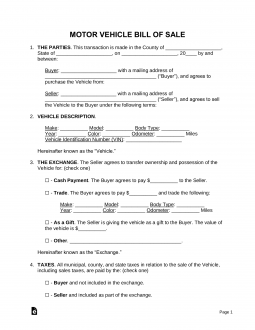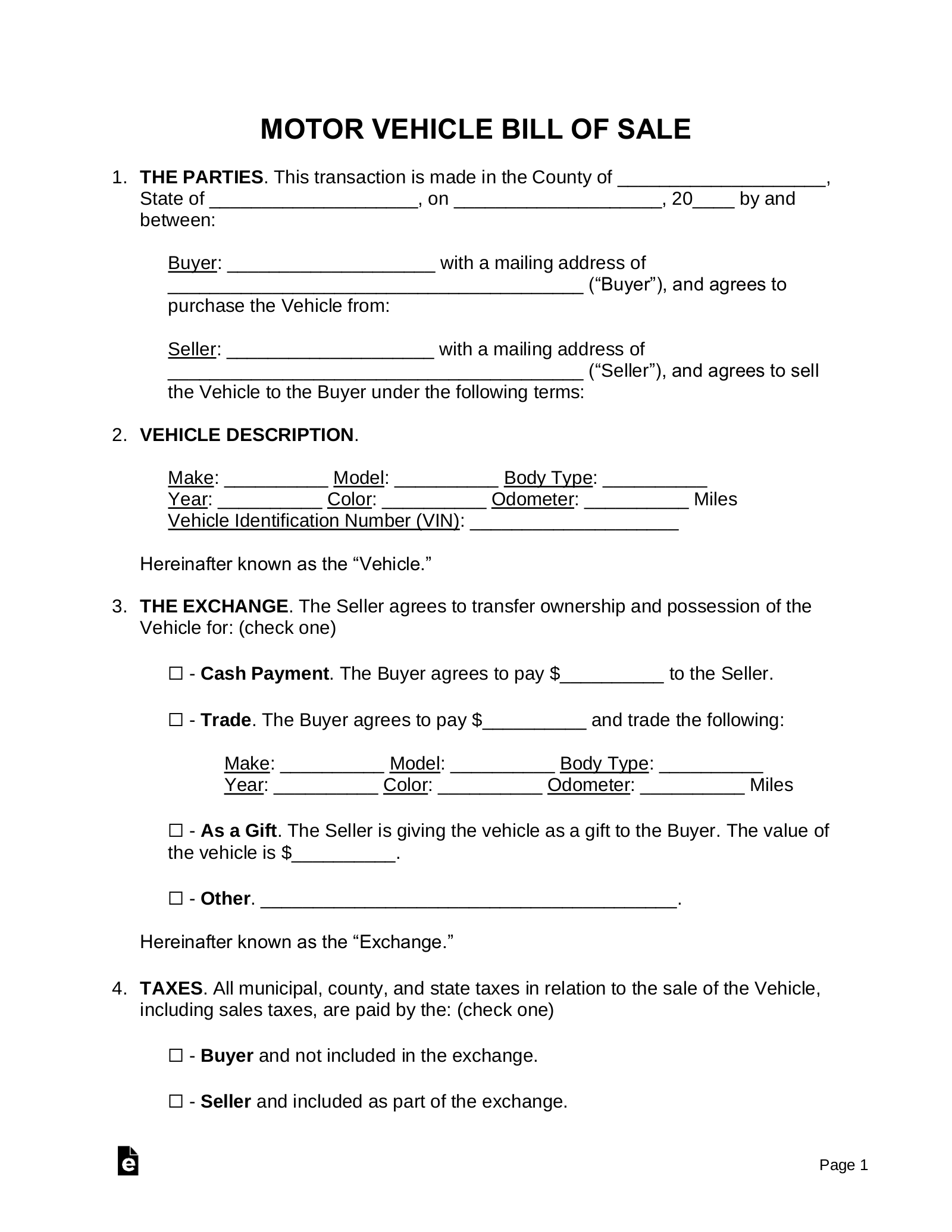Updated June 08, 2023
A motor vehicle bill of sale is between a buyer and a seller of a car, truck, or motorcycle. It is signed as the last step in the sales process after both parties have received possession of the exchange.
After signing, the buyer must keep an original copy of the bill of sale and certificate of title to register the vehicle. with their local DMV office.
By State
- Alabama
- Alaska
- Arizona
- Arkansas
- California
- Colorado
- Connecticut
- Delaware
- Florida
- Georgia
- Hawaii
- Idaho
- Illinois
- Indiana
- Iowa
- Kansas
- Kentucky
- Louisiana
- Maine
- Maryland
- Massachusetts
- Michigan
- Minnesota
- Mississippi
- Missouri
- Montana
- Nebraska
- Nevada
- New Hampshire
- New Jersey
- New Mexico
- New York
- North Carolina
- North Dakota
- Ohio
- Oklahoma
- Oregon
- Pennsylvania
- Rhode Island
- South Carolina
- South Dakota
- Tennessee
- Texas
- Utah
- Vermont
- Virginia
- Washington
- Washington D.C.
- West Virginia
- Wisconsin
- Wyoming
What is a Motor Vehicle Bill of Sale?
A motor vehicle bill of sale records the transaction between a buyer and seller for the purchase of a motor vehicle. The document can be used as proof of purchase, much like a receipt.
What Should It Include?
The form should include the following:
- Buyer’s name and address
- Seller’s name and address
- Vehicle description (i.e. make, model, year, and body style)
- Vehicle identification number (VIN)
- Sale date
- Transaction details (i.e. purchase price, trade, or gift)
- Warranty details (usually sold on an “as-is, where-is” basis)
Odometer Disclosure Statement
Federal law (49 U.S. Code § 32705) requires a bill of sale to include a verifying statement about the mileage of the vehicle. Vehicles more than 10 years old and over 16,000 pounds are exempt.
Sample
MOTOR VEHICLE BILL OF SALE
1. THE PARTIES. This transaction is made in the County of [COUNTY], State of [STATE], on [DATE], by and between:
Buyer: [BUYER’S NAME] with a mailing address of [BUYER’S ADDRESS] (“Buyer”), and agrees to purchase the Vehicle from:
Seller: [SELLER’S NAME] with a mailing address of [SELLER’S ADDRESS] (“Seller”), and agrees to sell the Vehicle to the Buyer under the following terms:
2. VEHICLE DESCRIPTION.
Make: [MAKE] Model: [MODEL] Body Type: [BODY TYPE]
Year: [YEAR] Color: [COLOR] Odometer: [#] Miles
Vehicle Identification Number (VIN): [17 DIGITS]
Hereinafter known as the “Vehicle.”
3. THE EXCHANGE. The Seller agrees to transfer ownership and possession of the Vehicle for: (check one)
☐ – Cash Payment. The Buyer agrees to pay $[AMOUNT] to the Seller.
☐ – Trade. The Buyer agrees to pay $[AMOUNT] and trade the following:
Make: [MAKE] Model: [MODEL] Body Type: [BODY TYPE]
Year: [YEAR] Color: [COLOR] Odometer: [#] Miles
☐ – As a Gift. The Seller is giving the vehicle as a gift to the Buyer. The value of the vehicle is $[AMOUNT].
☐ – Other. [OTHER].
Hereinafter known as the “Exchange.”
4. TAXES. All municipal, county, and state taxes in relation to the sale of the Vehicle, including sales taxes, are paid by the: (check one)
☐ – Buyer and not included in the exchange.
☐ – Seller and included as part of the exchange.
5. BUYER AND SELLER CONDITIONS.
The undersigned Seller affirms that the above information about the Vehicle is accurate to the best of their knowledge. The undersigned Buyer accepts receipt of this document and understands that the above vehicle is sold on an “as is, where is” condition with no guarantees or warranties, either expressed or implied.
6. AUTHORIZATION.
Buyer Signature: ________________________ Date: ____________
Print Name: ________________________
Seller Signature: ________________________ Date: ____________
Print Name: ________________________
ODOMETER DISCLOSURE STATEMENT
FEDERAL and STATE LAW requires that you state the mileage in connection with the transfer of ownership. Failure to complete or providing a false statement may result in fines and/or imprisonment.
I/We, [SELLER’S NAME], the Seller, certify to the best of my/our knowledge that the odometer reading of [#] Miles.
The actual mileage of the vehicle is accurate, unless one (1) of the following statements is checked ():
☐ – I hereby certify that the odometer reading reflects the amount of mileage in excess of its mechanical limits.
☐ – I hereby certify that the odometer reading is not the actual mileage. WARNING – ODOMETER DISCREPANCY
Buyer Signature: ________________________ Date: ____________
Print Name: ________________________
Seller Signature: ________________________ Date: ____________
Print Name: ________________________
NOTARY ACKNOWLEDGMENT
(SELLER ONLY)
A notary public or other officer completing this certificate verifies only the identity of the individual who signed the document to which this certificate is attached, and not the truthfulness, accuracy, or validity of that document.
State of ________________________ }
County of ________________________ }
On ________________________, 20____, before me, ________________________ (insert name and title of the officer), personally appeared ________________________ (seller’s name) who proved to me on the basis of satisfactory evidence to be the person whose name is subscribed within the Motor Vehicle Bill of Sale and acknowledged to me that they executed the same in their authorized capacity, and that by their signature on the instrument the person, or the entity upon behalf of which the person acted, executed the instrument.
I certify under PENALTY OF PERJURY under the laws of the state of ________________________ that the foregoing paragraph is true and correct.
WITNESS my hand and official seal.
Notary Public: ________________________
Print Name: ________________________
My Commission Expires: ________________________, 20____
(seal)


